Saga’s The Starlit Wood Sings!
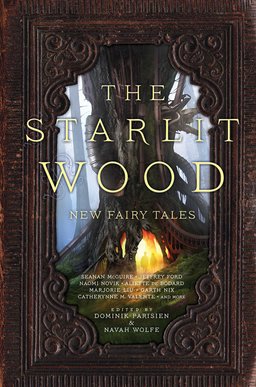
The Starlit Wood is an anthology of new fairy tales edited by Dominik Parisien and Navah Wolfe, and published by Saga Press.
It is, first of all, beautiful.
Beautiful to look at (just LOOK!), yes, but also to touch. So much care was poured into the initial aesthetics here; it is a book to fall in love with on sight. It has the appearance of both a very ancient — possibly magical — tome in a wizard’s tower, and of a peculiar stained glass window.
Is the image in the glass a tree that is also a doorway? Or is it that, on the other side of the window, there is a tree that is a doorway? And through that doorway, gold and flame.
The people who will love this book will love it before opening it, for the cover keeps its promises.
It begins with the Introduction. They wanted, wrote editors Wolfe and Parisien, for their authors to “move beyond the woods” of a traditional fairy tale. Now, in some stories this means “removing a piece traditionally viewed as integral to the story,” and in others, “putting a character as geographically far as possible from his or her original setting, as Little Red Riding Hood in the desert.” Perhaps most exciting of all (to me, anyway), it still other stories it means “exploring lesser-known or even newly discovered fairy tales.”
What they invite you into — that doorway through the tree, into flame? — is “an adventure that’s strangely familiar, and startlingly different.” And like the cover’s promises, Wolfe and Parisien make good their welcome.
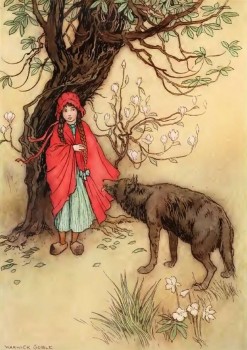 (I know I’m using their last names, coyly, professionally, but here is where I must disclose, as I do often in these book blogs o’ mine, that the editors — and even a few of the authors whose works are found herein — are friends. That’s okay. Sometimes when I’m talking to them RIGHT to their FACES, I still call them by their last names. Because it’s cool. Like we’re all on a football team together. Or characters in Hamilton.)
(I know I’m using their last names, coyly, professionally, but here is where I must disclose, as I do often in these book blogs o’ mine, that the editors — and even a few of the authors whose works are found herein — are friends. That’s okay. Sometimes when I’m talking to them RIGHT to their FACES, I still call them by their last names. Because it’s cool. Like we’re all on a football team together. Or characters in Hamilton.)
So.
Let’s begin a brief tour of this starry dark, this flameland, this space desert, this city wilderness, these woods.
“In the Desert Like a Bone,” by Seanan McGuire is a retelling of Little Red Riding Hood — as a Wild West VENGEANCE NARRATIVE. Wherein the wolf is not the worst character, and the girl? Well, let’s just say “Red” suits her. A tale both tough and lyrical, it sets the tone of the book. Basically: “This is not your grandma’s Grimm’s.”
“Underground,” by Karin Tidbeck, takes one of my favorite stories (which I always knew of as “East of the Sun, West of the Moon,” but which the author grew up reading as “Prince Hatt Underground”) and follows a girl sold off underground, married to a stranger, without the help of family and friends, who must learn to make her own choices and break terrible spells: not necessarily in that order.
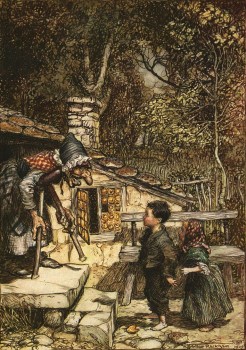 “Even the Crumbs Were Delicious,” by Daryl Gregory is, well, pretty frikkin hilarious, and simultaneously disturbing. Suffice to say the protagonist is the nicest, most laid-back “witch” I’ve ever seen represented in a Hansel and Gretel retelling, if a trifle, um, plastered from the wall paper. (It’s a drug reference. The “candy” house is papered in acid tabs, more or less.) The gentleness of the narrator made the brutality more flinchsome, but you have faith he’ll amble through the worst of it somehow — possibly because you see he already has.
“Even the Crumbs Were Delicious,” by Daryl Gregory is, well, pretty frikkin hilarious, and simultaneously disturbing. Suffice to say the protagonist is the nicest, most laid-back “witch” I’ve ever seen represented in a Hansel and Gretel retelling, if a trifle, um, plastered from the wall paper. (It’s a drug reference. The “candy” house is papered in acid tabs, more or less.) The gentleness of the narrator made the brutality more flinchsome, but you have faith he’ll amble through the worst of it somehow — possibly because you see he already has.
“The Super Ultra Duchess of Fedora Forest,” by Charlie Jane Anders is a retelling of one of those Grimms’ tales that are all animal characters. You know the ones? Like, “The Bremen Town Musicians” and “Cat and Mouse in Partnership“? This one doesn’t have ALL animals. In fact, it’s based on a little something called “The Bird, the Mouse, and the Sausage,” and features, well, you know, a talking sausage. Among other things. Anders commits wholeheartedly to the ridiculous surreality of it all, and follows the unlikely collaboration of the three titular entities in a world hardly at all like our own.
“Familiaris,” by Genevieve Valentine retells a story, “The Wolves,” I was not familiar with. The structure feels like a body that’s been flayed and butchered. Or perhaps two bodies, taken a part, then mixed together. All the fragments are there, grisly and gorgeous, to be studied singly and then, if your stomach is strong enough, to be pieced back together to see if you can recreate the whole.
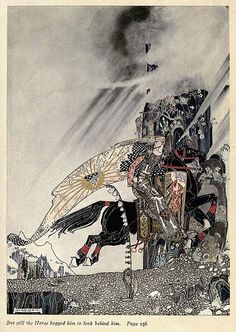 “Seasons of Glass and Iron,” by Amal El-Mohtar is the first of what I came to think of in this anthology as “women rescuing women”stories (though Tidbeck’s story earlier featured a woman rescuing herself) (and there are a few of those throughout as well). El-Mohtar (another friend to whom I refer by her last name, although occasionally I will shorten it to “Elm,” for we are VERY dear friends) writes with vigorous warmth, clarity, and compassion. But she doesn’t flinch from bleeding feet, self-defeat, and a world that traps women in impossible situations. The good news? Well, I said it at the beginning. It’s a story of women rescuing women. And I wanted to hug it when I was through. It’s the sort of candleflame-in-the-heart story that carries us through the cold times.
“Seasons of Glass and Iron,” by Amal El-Mohtar is the first of what I came to think of in this anthology as “women rescuing women”stories (though Tidbeck’s story earlier featured a woman rescuing herself) (and there are a few of those throughout as well). El-Mohtar (another friend to whom I refer by her last name, although occasionally I will shorten it to “Elm,” for we are VERY dear friends) writes with vigorous warmth, clarity, and compassion. But she doesn’t flinch from bleeding feet, self-defeat, and a world that traps women in impossible situations. The good news? Well, I said it at the beginning. It’s a story of women rescuing women. And I wanted to hug it when I was through. It’s the sort of candleflame-in-the-heart story that carries us through the cold times.
And if El-Mohtar’s story is a candleflame, then “Badgirl, the Deadman, and the Wheel of Fortune,” by Catherynne M. Valente, is the incinerator that burns your heart—and pretty much the rest of you—to ash. Is it a cathartic fire? Will we rise again, phoenix and firebird, fierce and free? Will our hands be our own again—or better: silver or gold or flame, where what was stolen had been merely flesh? Hard to say. Of “Badgirl,” Valente writes, “This is the only story I’ve written where I continually had to stop because I’d upset myself and needed to find some equilibrium again.” When a writer of such high genius has to pause mid-sentence to remind herself to breathe, you know you are in for a ferocious nosedive into bleakitude. But oh, it is worth it. It is worth it.
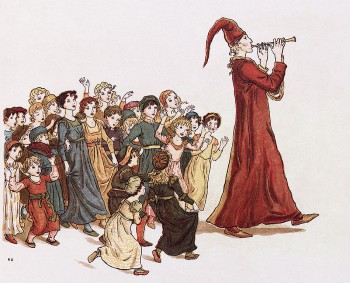 “Penny for a Match, Mister?” by Garth Nix features another Wild West-ish landscape, this time retelling Hans Christian Andersen’s “The Little Match Girl.” But here is no starveling waifling dying for want of warmth and food, slowly in the snow. Sure, the kid’s got magic matches—and she knows how to use ’em—and, like Red, her sister-in-vengeance in some parallel Wild Westverse, has good reason to do so–but she’s a dangerous wee tyke of a tatterdemalion, and not just to Bad Guys. Who’s gonna curb the feral shade inside her? Why, warden-marshal Rose Jackson, of course! And boy howdy, do I hope there are more stories of her!!! Apparently, “Penny” is one of a set of fantastical westerns, another being “Crossing the Line,” which I must seek out. The author ponders writing more, and — if my vote counts — YES PLEASE!
“Penny for a Match, Mister?” by Garth Nix features another Wild West-ish landscape, this time retelling Hans Christian Andersen’s “The Little Match Girl.” But here is no starveling waifling dying for want of warmth and food, slowly in the snow. Sure, the kid’s got magic matches—and she knows how to use ’em—and, like Red, her sister-in-vengeance in some parallel Wild Westverse, has good reason to do so–but she’s a dangerous wee tyke of a tatterdemalion, and not just to Bad Guys. Who’s gonna curb the feral shade inside her? Why, warden-marshal Rose Jackson, of course! And boy howdy, do I hope there are more stories of her!!! Apparently, “Penny” is one of a set of fantastical westerns, another being “Crossing the Line,” which I must seek out. The author ponders writing more, and — if my vote counts — YES PLEASE!
“Some Wait,” by Stephen Graham Jones is the story of disappearing children. Do you know this story? Does the word “Hamelin” mean anything to you? Rats? Okay, how about “Pied Piper”? Get it now? Yeah, it’s that one. It is a creepy, insidious story — first-person plural — told by the parents of the missing children. There’s something about reading a story told by a village of the damned that makes you complicit in their damnation. This one also features a haunted (or possessed) (or cursed) video game, which reminds me a little of “The Game” episode in Star Trek TNG, but maybe that’s just me.
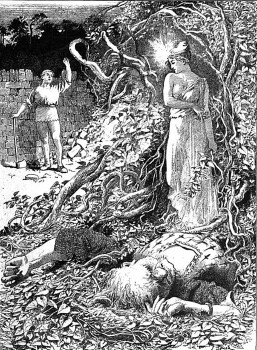 I can’t think back on my reading experience of Jeffrey Ford‘s “The Thousand Eyes” without smelling swamp and hearing Leonard Cohen. Now, Cohen has nothing to do with the story, but it’s his cracked and broken baritone (echoes, too, of Tom Waits and Greg Brown) that comes to mind when “RRRRRonnie DUNN, the Voice of Death” is described: “Low, menacing, but sometimes he’d hit a few sweet and beautiful notes. There was a rich resonance to its sound before it even hit the twang of the tinny speaker, like a song echoing down through a metal pipe from some strange other place. Off-putting at first, then intriguing, and eventually its appeal was hard to resist.” Perhaps that last description fits the story best as well. How clever of Mr. Ford to provide me the perfect soundbite! (If this were a vlog, and not a blog, that is.)
I can’t think back on my reading experience of Jeffrey Ford‘s “The Thousand Eyes” without smelling swamp and hearing Leonard Cohen. Now, Cohen has nothing to do with the story, but it’s his cracked and broken baritone (echoes, too, of Tom Waits and Greg Brown) that comes to mind when “RRRRRonnie DUNN, the Voice of Death” is described: “Low, menacing, but sometimes he’d hit a few sweet and beautiful notes. There was a rich resonance to its sound before it even hit the twang of the tinny speaker, like a song echoing down through a metal pipe from some strange other place. Off-putting at first, then intriguing, and eventually its appeal was hard to resist.” Perhaps that last description fits the story best as well. How clever of Mr. Ford to provide me the perfect soundbite! (If this were a vlog, and not a blog, that is.)
“Giants in the Sky,” by Max Gladstone made me bust out laughing. More than once. A lot. It’s one of those stories that I, personally, didn’t understand full half of, and yet—for all that—it’s totally accessible and enjoyable, and the half I did understand, I enjoyed the heck out of. I’d read it again just for ORM. What is it? Why, it’s a sci-fi retelling of “Jack and the Beanstalk.” Sort of. For Beanstalk read “space elevator rotated into higher-dimensional space.” And for Giants read “galaxy-striding post-humans who like to eff with leftover fleshy groundling humans.” And for ORM, read… ORM! Wait, wait, who’s ORM, you ask??? AND WELL YOU SHOULD! YOU WILL LOVE ORM! READ THIS STORY!
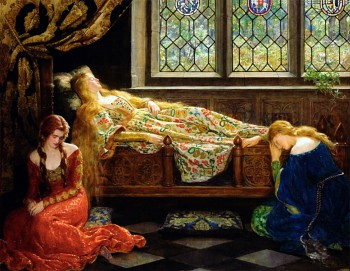 “The Briar and the Rose,” by Marjorie M. Liu is so lovely. Ah! And the second “women rescuing women” story — complete with a Duelist named Briar, a demonic, skin-hopping, parasite-witch-courtesan named Carmela, and her Sleeping-Maiden-host named Rose. It is full of love, intrigue, stinky cheese, and dangerous women. Watch for the garroting wire. Enjoy the ride. A right swashbuckler, this.
“The Briar and the Rose,” by Marjorie M. Liu is so lovely. Ah! And the second “women rescuing women” story — complete with a Duelist named Briar, a demonic, skin-hopping, parasite-witch-courtesan named Carmela, and her Sleeping-Maiden-host named Rose. It is full of love, intrigue, stinky cheese, and dangerous women. Watch for the garroting wire. Enjoy the ride. A right swashbuckler, this.
Theodora Goss‘s “The Other Thea” feels like a story set in a world that has a much wider and longer series. There is a school of witches in Boston. There is a girl who was separated from her shadow as a child. It’s a story about depression and identity, about the Other World where you go to find yourself and bargain yourself back again, about poetry that opens doorways, about learning how to live in your own skin. It is delicate and melancholy and also, strangely enough, a great deal of FUN. It left me hungry for more of this place, but the story set within the place satisfied, the way good fairy tales do.
“When I Lay Frozen,” by Margo Lanagan is a surprising Thumbelina/Tommelise retelling, of a tiny “flower spirit” who flees the house of her father and mother when she mistakes their lovemaking for trying to murder each other. But out in the world, she finds many pairings of animals who do just that — and some of them want to do that with her, due to a “pheromonal cloud around her that arouses everyone she meets.” Her caretaker is a dying mouse, and she waits underground while spiders weave her wedding trousseau, and the mole next door anticipates their wedding day. But as this is another “women rescuing women” story — or rather “swallow rescuing tiny girl-thing” — with a bit of luck, some spunk, some desperation, our heroine makes it out under the sunlight again, and into the sky. A really fascinating retelling, and one I’m still thinking about.
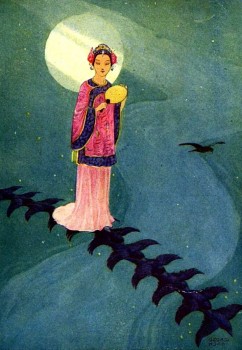 I have loved everything I have read thus far by Aliette de Bodard (which is, let’s face it, not nearly enough), and “Pearl” is no exception. The structure flips back and forth between past and present, telling of Da Trang, favorite councilor of “the Empress of the Dai Viet Empire, mistress of all her gaze and her mindships survey, protector of the named planets, raised and shaped to rule since her birth,” and his despairing search for a low-level AI — a “remora” named Pearl — whose needles pumped drugs and knowledge and subtlety into a young, ambitious, backwater would-be inventor, and raised him high in the Empress’s court. It is not a happy tale, but it is mysterious and vast. Its complexities click and whirr through my mind; I want to read more of this world. Or, rather, galaxy.
I have loved everything I have read thus far by Aliette de Bodard (which is, let’s face it, not nearly enough), and “Pearl” is no exception. The structure flips back and forth between past and present, telling of Da Trang, favorite councilor of “the Empress of the Dai Viet Empire, mistress of all her gaze and her mindships survey, protector of the named planets, raised and shaped to rule since her birth,” and his despairing search for a low-level AI — a “remora” named Pearl — whose needles pumped drugs and knowledge and subtlety into a young, ambitious, backwater would-be inventor, and raised him high in the Empress’s court. It is not a happy tale, but it is mysterious and vast. Its complexities click and whirr through my mind; I want to read more of this world. Or, rather, galaxy.
“The Tale of Mahliya and Mauhub and the White-Footed Gazelle,” by Sofia Samatar, I must say, was one of my two favorites. (The other being the last, “Spinning Silver,” but more on that later). From the first paragraph, I was caught. I laughed out loud in delight. Then I read it aloud to my beloved. Then I read him the second paragraph, because I couldn’t help but go on a little. I kept shaking my head and grinning. I had to get up and leave the room, because I wanted to read the whole thing aloud, but he was grading papers. The structure of the thing delighted me. The voice — the cackle and croak of it, the slyness, the eel-quick slipperiness, the shadow wings. Oh, and the “delectable little beak” blowing smoke! There are tales-within-the-tales, with pauses for asides and footnotes and snickering. That trickster witch: “vainest crone in Cairo.” Beauty, stain, momentum. The gazelles, yes, but oh, the lion! Every so often (every page or so) (pretty much all the pages), my entire body burst out in chills — wave upon wave of them — and by the end, I felt slightly dizzy and deliciously nauseated AND ALSO pretty darn close to TEARS IT WAS THAT GOOD!!! Augh, now I want to read it again.
“Reflected,” by Kat Howard is an entanglement-theory retelling of another of my favorites by H. C. Andersen, “The Snow Queen.” It has to do with mirrors, and time crystals, and the consequences of experimenting with things you don’t understand. Loss, brokenness, stubbornness, mending, remembering. The story is full of snow and glass, but it does not leave you cold. Quite the opposite, really. It leaves you warm and determined and, oddly, craving a pizza. Or maybe that’s just me.
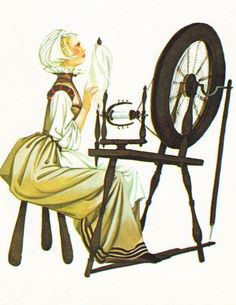 “Spinning Silver,” by Naomi Novik, was a stunning story to end the anthology on! I was already super-interested in examinations and subversions of “Rumpelstiltskin,” and again, from the first paragraph—when I realized that this was what was going on — I was hooked. Then, when I realized that the story wasn’t AT ALL WHAT I EXPECTED, ACTUALLY, I was triple-hooked, reeled in, and cast onto the shores of a brave new world. I loved every minute of it — although I did forget to breathe for a while there! How timely it is, Novik’s examination of history, of debt, of justice, of the monstrous, sublimated stereotypes in our most beloved fairy tales. And how fiercely, how entertainingly, how frighteningly she gives us back this new story, spun from the dross and straw of the old, turned into living gold.
“Spinning Silver,” by Naomi Novik, was a stunning story to end the anthology on! I was already super-interested in examinations and subversions of “Rumpelstiltskin,” and again, from the first paragraph—when I realized that this was what was going on — I was hooked. Then, when I realized that the story wasn’t AT ALL WHAT I EXPECTED, ACTUALLY, I was triple-hooked, reeled in, and cast onto the shores of a brave new world. I loved every minute of it — although I did forget to breathe for a while there! How timely it is, Novik’s examination of history, of debt, of justice, of the monstrous, sublimated stereotypes in our most beloved fairy tales. And how fiercely, how entertainingly, how frighteningly she gives us back this new story, spun from the dross and straw of the old, turned into living gold.
You know the phrase “that fairy tale feeling”? Maybe it’s just something I once read on Facebook. Right, yeah, on a thread by former Strange Horizons editor Karen Meisner. It’s all coming back to me now… Anyway, she mentioned a book that gave her “that fairy tale feeling,” and I so loved the phrase that I remembered it lo these many years later to pass it on to you now.
Are you searching for that fairy tale feeling in your own reading life? That deepening, that enrichening, that gilding and scarifying and ensorcelling of your inner landscape that changes the way you see the outside world in a myriad small ways? If so, then The Starlit Wood is the marvel-limned, shadow-skinned, witch-infested, magic-invested place to start.
 C. S. E. Cooney (csecooney.com/ <csecooney.com>@csecooney) is the World Fantasy Award-winning author of Bone Swans: Stories (Mythic Delirium 2015).
C. S. E. Cooney (csecooney.com/ <csecooney.com>@csecooney) is the World Fantasy Award-winning author of Bone Swans: Stories (Mythic Delirium 2015).
She is an audiobook narrator for Tantor Media, the singer/songwriter Brimstone Rhine, and the Rhysling Award-winning author of the poem “The Sea King’s Second Bride.” Her short fiction can be found in Black Gate, Strange Horizons, Apex, GigaNotoSaurus, Clockwork Phoenix 3 and 5, The Mammoth Book of Steampunk, and elsewhere.
It is indeed a beautiful book — I bought it the other day, and it’s on hand right now but I haven’t finished it.
But I’m really delighted to see someone mention Greg Brown — one of my absolute favorites!
Rich! HI! HALLO! I LOVE GREG BROWN WITH ALL MY HEART AND SOUL! Do you know HADESTOWN YET??? http://www.hadestown.com/ (He is the original voice of HADES, when it was still a concept album and not a fully fledged production.) (He is GREAT.) But of his own work, “Rexroth’s Daughter” is my favorite. It is also in my top ten of BEST SONGS EVER.
I absolutely love “Rexroth’s Daughter” — it might be my favorite, although almost all of that album is magnificent. (“Walkin’ Daddy” is another favorite, and “Blue Car”, and I could go on and on … “Laughing River” … “Two Little Feet” …) Do you know the story of Kenneth Rexroth’s actual daughter?
I had not heard of HADESTOWN … thank you! It looks fascinating, and what a great idea for a musical.
I think I remember trying to google Rexroth’s daughter, but didn’t get the story. TELL ME!!!
I am SO EXCITED for you to listen to Hadestown. You’ll get more out of the original album by Anais Mitchell than you will the “full cast” EP, which only has FOUR SONGS. (Doh!) Plus, you’ll also get Ani DiFranco as Persephone! OH, I HOPE YOU ENJOY IT!
I love “Two Little Feet.” Some of my other favorites is “If I Had Known.” And “Poet’s Game.” But I don’t have NEARLY enough Greg Brown in my life!!!
Kenneth Rexroth (significant American poet and critic in the mid 20th century)had a daughter named Mariana. Kenneth wasn’t a great father (or husband) as far as I can tell, and I think Mariana lived in San Francisco with her mother from the age of 11 or so. By the late ’60s she was doing pornographic films, and was featured in a Playboy article/photographic spread about “girls next door” doing X-rated films.
Greg Brown won’t say whether she was in any way a direct inspiration for the woman in his song — maybe not, though the one line (“daily naked for all the world to see”) might seem possibly a reference to the films and/or Playboy article.
Anyway, that’s what I found when I went looking for “Rexroth’s Daughter” on the web … I knew I remembered the name “Rexroth”, though I only barely remembered Kenneth Rexroth (who was kind of famous once but seems all but forgotten now).
Just ordered. And despite being one who doesn’t care that much about “collecting” books or what version or edition I have, I ordered the hardcover instead of the much cheaper (currently $7.99) Kindle version (or doing what I’d oftentimes do instead, waiting for a paperback or mass paperback version).
I don’t think you’ll regret holding an object of SUCH BEAUTY in your hands. Also, it has interesting bumps. By which I mean, it’s textured. DELICIOUS!
[…] Black Gate Magazine: Are you searching for that fairy tale feeling in your own reading life? That deepening, that enrichening, that gilding and scarifying and ensorcelling of your inner landscape that changes the way you see the outside world in a myriad small ways? If so, then The Starlit Wood is the marvel-limned, shadow-skinned, witch-infested, magic-invested place to start. […]